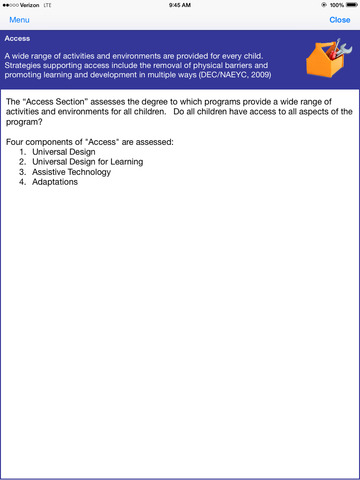
Quality Inclusive Practices Checklist
The Quality Inclusive Practices Checklist (QIPC) is a tool that supports assessment of quality inclusive practices within early childhood environments. The instrument is designed around three features used to define high-quality, inclusive early childhood programs and services: Access, Participation, and Supports (DEC/NAEYC, 2009). The QIPC measures each of these features with a variety of evidence-based indicators.
Practitioners can use the QIPC to assess quality inclusive practices within their early childhood environments. Action plans can then be produced to address areas of concern.
The QIPC can also be used as a teaching tool for collegiate early childhood classes, as usage encourages students to broaden their knowledge of what inclusive practices might look like in an early childhood environment. The toolboxes within the QIPC provide many opportunities for students to increase their knowledge of the features of inclusion.
Features:
• Ability to assess inclusive practices within any early childhood environment using Access, Participation, and Supports as a framework.
• The “Access Section” assesses the degree to which programs provide a wide range of activities and environments for all children including: Universal Design, Universal Design for Learning, Assistive Technology and Adaptations.
• The “Participation Section” assesses the range of instructional approaches used to promote engagement in play and learning activities for every child including: Embedded Instruction and Other Naturalistic Interventions, Scaffolding Strategies, and Tiered Models of Instruction.
• The “Supports Section” assesses the quality of systemic supports built into the program to support professionals and families and includes: professional development, models of collaboration, and family-professional collaboration.
• Each section and indicator includes a toolbox of resources to further explore that particular concept. Resources include articles, online application activities, and videos.
• An extensive in-text glossary is available for highlighted words within the QIPC.
• Action plans and summary pages can be created at the end of the QIPC to aid in program reviews and improvement plans.



